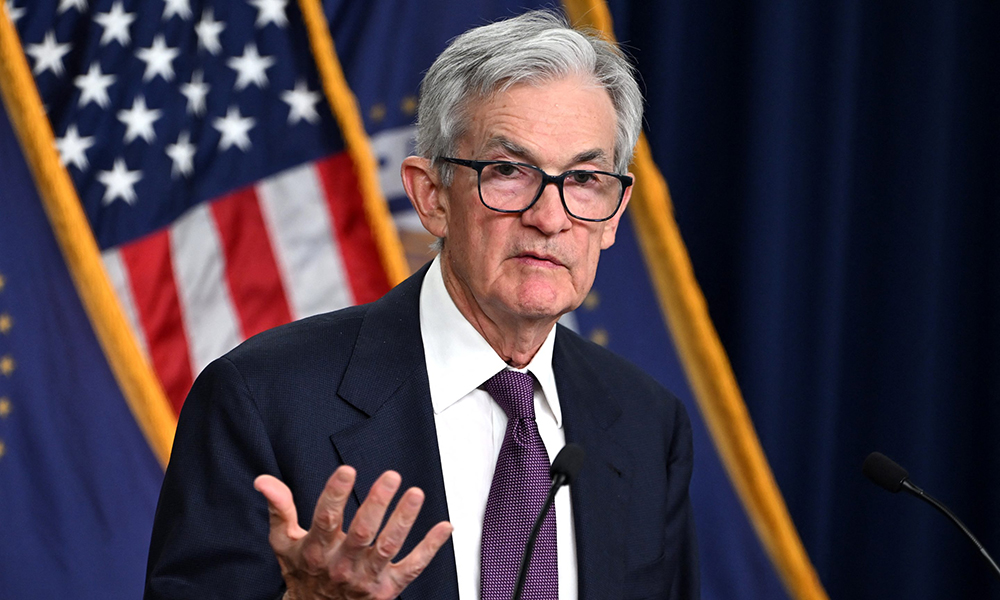
2024年最后幾個(gè)月,,為了降低借款成本,美聯(lián)儲(chǔ)終于在萬眾期待中降息,。然而,,債券市場(chǎng)卻拒絕配合美聯(lián)儲(chǔ)的動(dòng)作,上周的固定收益產(chǎn)品拋售延續(xù)到了本周一,。周一上午,,基準(zhǔn)10年期國(guó)債的收益率短暫突破了4.8%,達(dá)到自2023年11月以來的最高水平,,而30年期國(guó)債的收益率接近5%,。債券價(jià)格下降時(shí),其收益率就會(huì)上升,。債券收益率升高,,反過來會(huì)影響抵押貸款和各類貸款的成本。
出現(xiàn)這種情況的一個(gè)主要原因是上周遠(yuǎn)超預(yù)期的就業(yè)報(bào)告,,使華爾街好奇美聯(lián)儲(chǔ)在2025年是否會(huì)繼續(xù)降息,。與此同時(shí),隨著唐納德·特朗普即將就任,,有人擔(dān)心這位新當(dāng)選總統(tǒng)的關(guān)稅,、減稅和大規(guī)模驅(qū)逐非法移民等政策可能會(huì)導(dǎo)致通脹加劇。無論如何,大幅升高的收益率正在對(duì)股票市場(chǎng)產(chǎn)生影響,,而且一些市場(chǎng)觀察者將債券視為潛在的投資機(jī)會(huì),。
去年10月,隨著對(duì)經(jīng)濟(jì)衰退的擔(dān)憂減弱,,債券收益率在強(qiáng)勁就業(yè)數(shù)據(jù)公布后開始上升,。兩個(gè)月后,聯(lián)邦開放市場(chǎng)委員會(huì)(Federal Open Market Committee)暗示2025年的降息次數(shù)將少于之前的預(yù)期,,令投資者大失所望,。聯(lián)信銀行(Comerica Bank)首席經(jīng)濟(jì)學(xué)家比爾·亞當(dāng)斯在周一的一份報(bào)告中指出,聯(lián)邦開放市場(chǎng)委員會(huì)12月開會(huì)的會(huì)議記錄顯示,,美聯(lián)儲(chǔ)的決策者們一致認(rèn)為,,通貨膨脹升高的風(fēng)險(xiǎn)增加。
然后是上周五的就業(yè)報(bào)告,。美國(guó)勞工統(tǒng)計(jì)局(Bureau of Labor Statistics)披露的數(shù)據(jù)顯示,,去年12月,非農(nóng)就業(yè)人數(shù)增加25.6萬人,,超出預(yù)期的15.5萬,。強(qiáng)勁的就業(yè)數(shù)據(jù)讓投資者擔(dān)心美聯(lián)儲(chǔ)會(huì)繼續(xù)降息,還是改變政策進(jìn)行加息以應(yīng)對(duì)物價(jià)上漲,。
這種擔(dān)憂影響了股市,,導(dǎo)致標(biāo)普500指數(shù)在過去五天內(nèi)下跌了2.5%。貝雅私人財(cái)富管理公司(Baird Private Wealth Management)的投資策略師羅斯·梅菲爾德在上周五的一份報(bào)告中表示,,要分析最近的市場(chǎng)波動(dòng),,首先應(yīng)該從長(zhǎng)期債券收益率著手。
他指出,,更高的借款成本(目前抵押貸款利率接近7%)給整體經(jīng)濟(jì)帶來了壓力,。他補(bǔ)充道,更高利率還會(huì)減少企業(yè)利潤(rùn)和壓縮估值倍數(shù),,從而影響股價(jià),。
梅菲爾德表示:“債券收益率在美聯(lián)儲(chǔ)降息后上升是不尋常的,而美聯(lián)儲(chǔ)在經(jīng)濟(jì)衰退尚未顯現(xiàn)的情況下選擇降息的經(jīng)濟(jì)背景同樣不尋常,。收益率的上升可能反映了以下幾個(gè)因素的綜合作用:強(qiáng)于預(yù)期的經(jīng)濟(jì)增長(zhǎng),、對(duì)第二波通貨膨脹的擔(dān)憂(可能由關(guān)稅和移民政策的變化引發(fā))、持續(xù)的預(yù)算赤字和國(guó)家債務(wù)問題,,以及進(jìn)入2025年后美聯(lián)儲(chǔ)可能會(huì)采取更強(qiáng)硬的政策,。”
美債拋售是否會(huì)帶來機(jī)會(huì),?
諷刺的是,,美債拋售可能給投資者重新進(jìn)入固定收益市場(chǎng)創(chuàng)造條件,。例如,隨著投資者通過持有美國(guó)政府債務(wù)獲得的無風(fēng)險(xiǎn)回報(bào)增加,,股票對(duì)投資者來說可能顯得更昂貴,。
《華爾街日?qǐng)?bào)》的喬恩·辛德雷烏最近認(rèn)為,全球債券收益率上升不應(yīng)讓投資者擔(dān)心發(fā)達(dá)國(guó)家會(huì)出現(xiàn)債務(wù)違約,。他寫道:“更重要的是,,與通脹掛鉤的美國(guó)國(guó)債也被拋售,這表明市場(chǎng)并不認(rèn)為經(jīng)濟(jì)過熱和關(guān)稅是一個(gè)嚴(yán)重的通脹問題,?!?/p>
相反,他認(rèn)為長(zhǎng)期收益率上升是合理的,,因?yàn)橥顿Y者排除了短期內(nèi)經(jīng)濟(jì)衰退的可能性,,并要求長(zhǎng)期鎖定他們的資金應(yīng)該帶來更高的回報(bào)。這解釋了10年期和30年期國(guó)債等資產(chǎn)的期限溢價(jià)增加的原因,,期限溢價(jià)補(bǔ)償了投資者所承擔(dān)的因利率隨時(shí)間變化帶來的風(fēng)險(xiǎn),。
上周,,美國(guó)銀行(Bank of America)的經(jīng)濟(jì)學(xué)家宣布美聯(lián)儲(chǔ)的降息周期應(yīng)該結(jié)束,。 美國(guó)銀行信用策略師尤里·塞林格、吉恩-提亞哥·哈姆和素賢·瑪麗·李在上周五的一份報(bào)告中寫道:“美聯(lián)儲(chǔ)加息的門檻仍然很高,。這限制了加息的幅度,,以及擴(kuò)大(投資級(jí))利差的幅度?!?/p>
不過,,千萬不要試圖向想買房的人兜售這種樂觀情緒。(財(cái)富中文網(wǎng))
譯者:劉進(jìn)龍
審校:汪皓
2024年最后幾個(gè)月,,為了降低借款成本,,美聯(lián)儲(chǔ)終于在萬眾期待中降息。然而,,債券市場(chǎng)卻拒絕配合美聯(lián)儲(chǔ)的動(dòng)作,,上周的固定收益產(chǎn)品拋售延續(xù)到了本周一。周一上午,,基準(zhǔn)10年期國(guó)債的收益率短暫突破了4.8%,,達(dá)到自2023年11月以來的最高水平,而30年期國(guó)債的收益率接近5%,。債券價(jià)格下降時(shí),,其收益率就會(huì)上升。債券收益率升高,,反過來會(huì)影響抵押貸款和各類貸款的成本,。
出現(xiàn)這種情況的一個(gè)主要原因是上周遠(yuǎn)超預(yù)期的就業(yè)報(bào)告,使華爾街好奇美聯(lián)儲(chǔ)在2025年是否會(huì)繼續(xù)降息。與此同時(shí),,隨著唐納德·特朗普即將就任,,有人擔(dān)心這位新當(dāng)選總統(tǒng)的關(guān)稅、減稅和大規(guī)模驅(qū)逐非法移民等政策可能會(huì)導(dǎo)致通脹加劇,。無論如何,,大幅升高的收益率正在對(duì)股票市場(chǎng)產(chǎn)生影響,而且一些市場(chǎng)觀察者將債券視為潛在的投資機(jī)會(huì),。
去年10月,,隨著對(duì)經(jīng)濟(jì)衰退的擔(dān)憂減弱,債券收益率在強(qiáng)勁就業(yè)數(shù)據(jù)公布后開始上升,。兩個(gè)月后,,聯(lián)邦開放市場(chǎng)委員會(huì)(Federal Open Market Committee)暗示2025年的降息次數(shù)將少于之前的預(yù)期,令投資者大失所望,。聯(lián)信銀行(Comerica Bank)首席經(jīng)濟(jì)學(xué)家比爾·亞當(dāng)斯在周一的一份報(bào)告中指出,,聯(lián)邦開放市場(chǎng)委員會(huì)12月開會(huì)的會(huì)議記錄顯示,美聯(lián)儲(chǔ)的決策者們一致認(rèn)為,,通貨膨脹升高的風(fēng)險(xiǎn)增加,。
然后是上周五的就業(yè)報(bào)告。美國(guó)勞工統(tǒng)計(jì)局(Bureau of Labor Statistics)披露的數(shù)據(jù)顯示,,去年12月,,非農(nóng)就業(yè)人數(shù)增加25.6萬人,超出預(yù)期的15.5萬,。強(qiáng)勁的就業(yè)數(shù)據(jù)讓投資者擔(dān)心美聯(lián)儲(chǔ)會(huì)繼續(xù)降息,,還是改變政策進(jìn)行加息以應(yīng)對(duì)物價(jià)上漲。
這種擔(dān)憂影響了股市,,導(dǎo)致標(biāo)普500指數(shù)在過去五天內(nèi)下跌了2.5%,。貝雅私人財(cái)富管理公司(Baird Private Wealth Management)的投資策略師羅斯·梅菲爾德在上周五的一份報(bào)告中表示,要分析最近的市場(chǎng)波動(dòng),,首先應(yīng)該從長(zhǎng)期債券收益率著手,。
他指出,更高的借款成本(目前抵押貸款利率接近7%)給整體經(jīng)濟(jì)帶來了壓力,。他補(bǔ)充道,,更高利率還會(huì)減少企業(yè)利潤(rùn)和壓縮估值倍數(shù),從而影響股價(jià),。
梅菲爾德表示:“債券收益率在美聯(lián)儲(chǔ)降息后上升是不尋常的,,而美聯(lián)儲(chǔ)在經(jīng)濟(jì)衰退尚未顯現(xiàn)的情況下選擇降息的經(jīng)濟(jì)背景同樣不尋常。收益率的上升可能反映了以下幾個(gè)因素的綜合作用:強(qiáng)于預(yù)期的經(jīng)濟(jì)增長(zhǎng),、對(duì)第二波通貨膨脹的擔(dān)憂(可能由關(guān)稅和移民政策的變化引發(fā)),、持續(xù)的預(yù)算赤字和國(guó)家債務(wù)問題,,以及進(jìn)入2025年后美聯(lián)儲(chǔ)可能會(huì)采取更強(qiáng)硬的政策?!?/p>
美債拋售是否會(huì)帶來機(jī)會(huì),?
諷刺的是,美債拋售可能給投資者重新進(jìn)入固定收益市場(chǎng)創(chuàng)造條件,。例如,,隨著投資者通過持有美國(guó)政府債務(wù)獲得的無風(fēng)險(xiǎn)回報(bào)增加,股票對(duì)投資者來說可能顯得更昂貴,。
《華爾街日?qǐng)?bào)》的喬恩·辛德雷烏最近認(rèn)為,,全球債券收益率上升不應(yīng)讓投資者擔(dān)心發(fā)達(dá)國(guó)家會(huì)出現(xiàn)債務(wù)違約。他寫道:“更重要的是,,與通脹掛鉤的美國(guó)國(guó)債也被拋售,,這表明市場(chǎng)并不認(rèn)為經(jīng)濟(jì)過熱和關(guān)稅是一個(gè)嚴(yán)重的通脹問題?!?/p>
相反,,他認(rèn)為長(zhǎng)期收益率上升是合理的,因?yàn)橥顿Y者排除了短期內(nèi)經(jīng)濟(jì)衰退的可能性,,并要求長(zhǎng)期鎖定他們的資金應(yīng)該帶來更高的回報(bào),。這解釋了10年期和30年期國(guó)債等資產(chǎn)的期限溢價(jià)增加的原因,期限溢價(jià)補(bǔ)償了投資者所承擔(dān)的因利率隨時(shí)間變化帶來的風(fēng)險(xiǎn),。
上周,,美國(guó)銀行(Bank of America)的經(jīng)濟(jì)學(xué)家宣布美聯(lián)儲(chǔ)的降息周期應(yīng)該結(jié)束,。 美國(guó)銀行信用策略師尤里·塞林格,、吉恩-提亞哥·哈姆和素賢·瑪麗·李在上周五的一份報(bào)告中寫道:“美聯(lián)儲(chǔ)加息的門檻仍然很高。這限制了加息的幅度,,以及擴(kuò)大(投資級(jí))利差的幅度,。”
不過,,千萬不要試圖向想買房的人兜售這種樂觀情緒,。(財(cái)富中文網(wǎng))
譯者:劉進(jìn)龍
審校:汪皓
The long-awaited interest rate cuts from the Federal Reserve in the final months of 2024 aimed to lower borrowing costs. Bond markets are refusing to cooperate, however, as last week’s fixed-income sell-off carried into Monday. The yield on the benchmark 10-year Treasury, which rises as the price of the bond falls, briefly surged above the 4.8% mark Monday morning, its highest level since November 2023, while its 30-year counterpart is on the cusp of hitting 5%. Those rising rates will in turn carry over to the cost of mortgages and loans of all sorts.
A big reason for all this is last week’s blowout jobs report, which left Wall Street wondering whether the Fed will continue its rate-cutting regime in 2025. Meanwhile, on the cusp of Donald Trump’s inauguration, there are fears the President-elect’s policies on tariffs, tax cuts, and mass deportations could prove inflationary. Whatever the case, a steepening yield curve is weighing on stocks, and some market watchers are eyeing bonds as a potential opportunity for investors.
Yields began their upswing off the back of strong monthly jobs data in October as recession fears eased. Two months later, the Federal Open Market Committee disappointed investors by signaling fewer cuts in 2025 than previously expected. As Bill Adams, chief economist at Comerica Bank, noted in a note on Monday, the minutes of the committee’s December meeting showed the Fed’s decision makers all agreed upside risk to inflation had increased.
Then came Friday’s jobs report. The Bureau of Labor Statistics revealed nonfarm payrolls grew by 256,000 in December, blowing away the expected number of 155,000. The strong labor data spooked investors now wondering whether the Fed will slash rates at all—or even reverse course and hike rates to fight rising prices.
Those fears have hit the stock market, leading the S&P 500 to sink 2.5% over the past five days. When unpacking the recent market volatility, however, long-term bond yields are the place to start, Ross Mayfield, an investment strategist at Baird Private Wealth Management, said in a note Friday.
Elevated borrowing costs—mortgage rates currently sit near 7% —burden broader economic activity, he noted. Higher interest rates also dent corporate profits and compress valuation multiples, he added, which weighs on stock prices.
“This is an unusual move following Fed rate cuts, but then again, so is the economic backdrop of the Fed cutting rates without a recession looming,” Mayfield said. “The move in yields likely reflects some combination of stronger-than-expected economic growth, fears of a second wave of inflation (potentially spurred on by changes to tariff and immigration policy), the lingering budget deficit/national debt issue, and a more hawkish Fed entering 2025.”
Could the bond sell-off present opportunity?
Ironically, the bond sell-off may be creating conditions for investors to jump back in to the fixed-income market. Stocks may appear more expensive to investors, for example, as the risk-free return that investors can obtain by holding U.S. government debt increases.
The Wall Street Journal’s Jon Sindreu recently argued that the surge in yields across the globe shouldn’t make investors worried about developed countries defaulting on their debt. “More important, inflation-linked Treasurys have sold off too,” he wrote, “belying the idea that markets see a hot economy and tariffs as a serious inflationary problem.”
Instead, he argued the jump in long-term yields makes sense as investors rule out the possibility of an economic downturn in the short run and demand a higher return for locking up their money for extended periods. That explains the increase in the term premium for assets like the 10- and 30-year Treasury, which compensates investors for the risk of interest rates changing over time.
Last week, Bank of America economists declared that the Fed’s rate-cutting cycle should be over. “Still, the bar for Fed hikes remains high,” BofA credit strategists Yuri Selinger, Jean-Tiago Hamm, and Sohyun Marie Lee wrote in a note Friday. “That puts a limit on how much higher rates can go, and how much more [investment grade] spreads could widen.”
Just don’t attempt to sell all this optimism to someone trying to buy a house.






